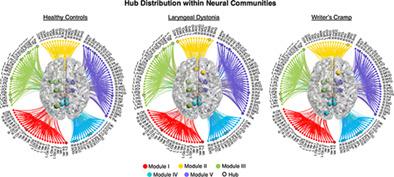当前位置:
X-MOL 学术
›
Hum. Brain Mapp.
›
论文详情
Our official English website, www.x-mol.net, welcomes your
feedback! (Note: you will need to create a separate account there.)
The large-scale structural connectome of task-specific focal dystonia.
Human Brain Mapping ( IF 3.5 ) Pub Date : 2020-04-20 , DOI: 10.1002/hbm.25012 Sandra Hanekamp 1, 2 , Kristina Simonyan 1, 2, 3
Human Brain Mapping ( IF 3.5 ) Pub Date : 2020-04-20 , DOI: 10.1002/hbm.25012 Sandra Hanekamp 1, 2 , Kristina Simonyan 1, 2, 3
Affiliation

|
The emerging view of dystonia is that of a large‐scale functional network disorder, in which the communication is disrupted between sensorimotor cortical areas, basal ganglia, thalamus, and cerebellum. The structural underpinnings of functional alterations in dystonia are, however, poorly understood. Notably, it is unclear whether structural changes form a larger‐scale dystonic network or rather remain focal to isolated brain regions, merely underlying their functional abnormalities. Using diffusion‐weighted imaging and graph theoretical analysis, we examined inter‐regional white matter connectivity of the whole‐brain structural network in two different forms of task‐specific focal dystonia, writer's cramp and laryngeal dystonia, compared to healthy individuals. We show that, in addition to profoundly altered functional network in focal dystonia, its structural connectome is characterized by large‐scale aberrations due to abnormal transfer of prefrontal and parietal nodes between neural communities and the reorganization of normal hub architecture, commonly involving the insula and superior frontal gyrus in patients compared to controls. Other prominent common changes involved the basal ganglia, parietal and cingulate cortical regions, whereas premotor and occipital abnormalities distinctly characterized the two forms of dystonia. We propose a revised pathophysiological model of focal dystonia as a disorder of both functional and structural connectomes, where dystonia form‐specific abnormalities underlie the divergent mechanisms in the development of distinct clinical symptomatology. These findings may guide the development of novel therapeutic strategies directed at targeted neuromodulation of pathophysiological brain regions for the restoration of their structural and functional connectivity.
中文翻译:

任务特定的局灶性肌张力障碍的大规模结构连接组。
肌张力障碍的新观点是一种大规模的功能性网络障碍,其中感觉运动皮层区、基底神经节、丘脑和小脑之间的交流中断。然而,对肌张力障碍功能改变的结构基础知之甚少。值得注意的是,目前尚不清楚结构变化是否形成了更大规模的肌张力障碍网络,或者是否仍然集中在孤立的大脑区域,仅仅是其功能异常的基础。使用弥散加权成像和图形理论分析,我们检查了与健康个体相比,在两种不同形式的任务特定局灶性肌张力障碍(写作痉挛和喉肌张力障碍)中全脑结构网络的区域间白质连通性。我们表明,除了局灶性肌张力障碍的功能网络发生深刻改变外,其结构连接组的特点是由于神经群落之间前额叶和顶叶节点的异常转移以及正常中枢结构的重组而出现大规模畸变,通常涉及脑岛和额上回。患者与对照组相比。其他突出的常见变化涉及基底神经节、顶叶和扣带回皮层区域,而运动前和枕叶异常明显地表征了两种形式的肌张力障碍。我们提出了一种修订的局灶性肌张力障碍病理生理学模型,该模型是一种功能性和结构性连接组疾病,其中肌张力障碍形式特异性异常是不同临床症状发展的不同机制的基础。
更新日期:2020-04-20
中文翻译:

任务特定的局灶性肌张力障碍的大规模结构连接组。
肌张力障碍的新观点是一种大规模的功能性网络障碍,其中感觉运动皮层区、基底神经节、丘脑和小脑之间的交流中断。然而,对肌张力障碍功能改变的结构基础知之甚少。值得注意的是,目前尚不清楚结构变化是否形成了更大规模的肌张力障碍网络,或者是否仍然集中在孤立的大脑区域,仅仅是其功能异常的基础。使用弥散加权成像和图形理论分析,我们检查了与健康个体相比,在两种不同形式的任务特定局灶性肌张力障碍(写作痉挛和喉肌张力障碍)中全脑结构网络的区域间白质连通性。我们表明,除了局灶性肌张力障碍的功能网络发生深刻改变外,其结构连接组的特点是由于神经群落之间前额叶和顶叶节点的异常转移以及正常中枢结构的重组而出现大规模畸变,通常涉及脑岛和额上回。患者与对照组相比。其他突出的常见变化涉及基底神经节、顶叶和扣带回皮层区域,而运动前和枕叶异常明显地表征了两种形式的肌张力障碍。我们提出了一种修订的局灶性肌张力障碍病理生理学模型,该模型是一种功能性和结构性连接组疾病,其中肌张力障碍形式特异性异常是不同临床症状发展的不同机制的基础。









































 京公网安备 11010802027423号
京公网安备 11010802027423号